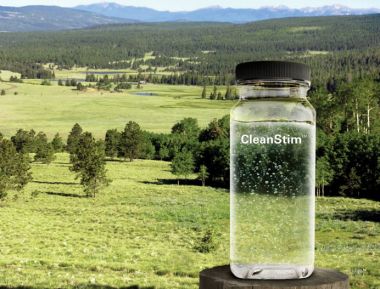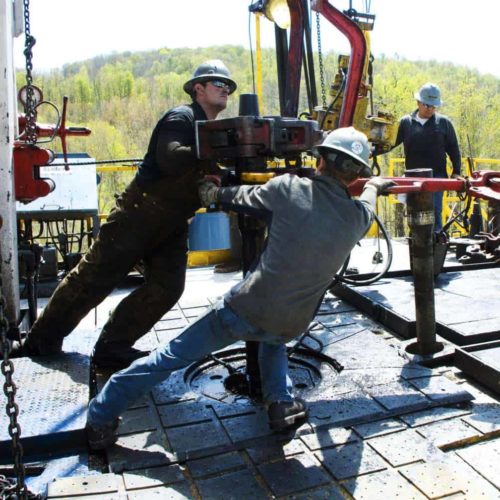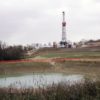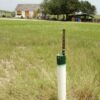Introduction
A liquid concoction, often laced with toxic chemicals, is a central villain in the controversy over extracting natural gas by fracturing rock beneath the earth’s surface. Opponents fear this fracking fluid may foul water supplies, endangering human health and the environment.

Adapting, the industry is responding to public concern. Giant energy services company Halliburton, in a safety demonstration at an August 3 industry conference in Colorado, had an employee demonstrate just how palatable fracking fluid can be. He drank it.
But the formula was different this time, the company says – more environmentally friendly because it is made from ingredients used by the food industry, including sweeteners found in chocolate, partially hydrogenated vegetable oil, and part of recipes for baby wipes and shampoos.
Totally safe, says Halliburton spokesperson Tara Mullee Agard – though “not intended for human consumption.”
To some, it may be surprising that companies are responding at all. Even if the formula turns out to be more of a public relations ploy than a fix, the industry expects little meaningful resistance from Washington. For all the furor over fracking, opponents’ best hopes for action appear to be many months if not years away. Business is gaining so much momentum – and the political anti-regulatory mood so pervasive – that analysts foresee few barriers to growth.
While some states and local governments are aggressively setting up safeguards and barriers to the industry, the Obama administration – under pressure from Republicans and slowed by the bureaucratic process itself – is moving slowly to study or craft new rules.
Energy analysts told iWatch News that a spate of recent scrutiny and criticism – along with recent recommendations from an Energy Department advisory panel calling for more disclosure of the chemicals used in fracking, as well as better protection of air and water nearby – have had little impact on the industry’s prospects.
“This is not going to derail the industry. The industry is still big and growing,” said Fadel Gheit, an analyst with Oppenheimer & Co. The resistance of environmental groups is only “going to put a [temporary] hurdle in front of them,” he added.
As if to underscore the industry’s self-assurance, Halliburton came up with the new way to counter perceptions that the solution of chemicals used in fracking is necessarily toxic and could jeopardize drinking water supplies. Another energy field services company has added citrus scents to its fracking formula. Halliburton’s industry advertising cautions that CleanStim, the new fracking fluid swigged by the employee at the conference, is “designed for downhole use, not dinner tables.”
Fracking, also known as hydraulic fracturing, is used to tap previously unreachable deposits of natural gas in the earth. Sand, water and chemicals are pumped into shale formations to release and then capture the gas. Critics say fracking could be tainting groundwater, killing wildlife and as iWatch News has reported, giving off methane gas that contributes to global warming.
But the drilling technique evolved outside the bounds of existing regulation, and federal, state and local authorities are only beginning to weigh possible rules to apply to the industry. Several federal agencies that could limit fracking are expected to study the issues for many more months; even if the administration decides on a course of action, federal officials confirmed to iWatch News, the rule-making process could drag on for many months if not years.
The Department of Interior, the Environmental Protection Agency and the U.S. Forest Service, part of the Agriculture Department, all could have a hand in regulation of fracking. Thus far, none of the agencies has indicated they have plans to move in that direction, though EPA spokesperson Betsaida Alcantara said the agency “will not hesitate to take any steps under the law to protect Americans whose health may be at risk.”
An EPA study of water quality issues won’t be finished until 2012. A proposed EPA rule, which could limit air pollution as a result of drilling and won’t be final until next February, doesn’t address groundwater contamination, a chief concern of many environmental groups. Congress in 2005 made the chemicals used in fracking exempt from disclosure because they have been considered trade secrets.
Department of Interior spokesman Adam Fetcher said officials were working with representatives from industry and public interest groups to make sure natural gas on public lands “is developed in a safe and environmentally sustainable manner.”
‘Only so much administration can do’
Environmentalists cheered when the Forest Service in May proposed banning fracking in George Washington National Forest, in Western Virginia, but Joel Holtrop, deputy chief of the national forest system, said the agency has no plans for a wider-ranging limit. “We don’t have a policy or any plans to make a policy that would ban horizontal drilling or hydraulic fracturing.”
Earlier this month, an Energy Department advisory committee called for tougher standards on air pollution and greenhouse gases associated with fracking, disclosure of the potentially carcinogenic ingredients in fracking fluid, as well as better tracking and disposal of waste and curtailing the use of diesel fuel from the fluid.
“The public deserves assurance that the full economic, environmental and energy security benefits of shale gas development will be realized without sacrificing public health, environmental protection and safety,” said the report, prepared by a subcommittee reporting to Energy Secretary Steven Chu.
While the Energy Department doesn’t regulate fracking or the environment, the report appeared to give a boost to environmental groups, who have been trying to put pressure on national leaders, including Obama.
Nonprofit environmental law firm Earthjustice, supported by dozens of other organizations, petitioned the EPA two weeks ago, urging further study of the chemicals used in the process and their toxicity. Last Monday, a number of green groups demanded that Obama “employ any legal means to put a halt to hydraulic fracturing” on federal lands.
Employees for environmental groups, in interviews with iWatch News, acknowledged the president’s limitations. “There’s only so much the administration can do,” said Kyle Ash, a lobbyist at Greenpeace, among the organizations urging Obama to halt fracking.
Fracking opponents’ expectations center more on piecemeal victories – for instance, rejection of specific requests for permission to drill on federal land. That’s “one thing the administration can do right now,” Ash noted. “Anytime there’s a federal permit required, they could put a halt on it.”
The government also could prevent companies from drilling on lands owned by the federal government, much as it did with exploratory drilling following the Deepwater Horizon incident.
But even a full-scale moratorium would affect only a small percentage of the nation’s total natural gas output. Most fracking takes place on lands where the federal government has little or no jurisdiction. As of 2009, about 13 percent of the nation’s onshore natural gas was drilled on federal lands, according to the Bureau of Land Management. About 90 percent of that was a result of fracking.
Election-year politics and resistance of many Republicans in Congress to regulations, especially involving the EPA, also suggests substantial inaction on fracking. Michael A. Levi, who specializes in energy and environment at the Council on Foreign Relations, a nonpartisan foreign policy think tank, anticipates little movement on the issue in Washington. “We’re very unlikely to see a situation where regulators can do anything beyond the current authority, which is pretty limited,” said Levi.
Industry sees no reason for ban
Obama has been a prime backer of natural gas, which he endorsed most visibly during this year’s State of the Union address. The president has acknowledged environmental and safety concerns but says drilling can be done safely.
At an April town hall, for instance, Obama noted that the technologies for extracting natural gas “aren’t as developed as we’d like and so there are some concerns that it might create pollution in our groundwater, for example. So we’ve got to make sure that if we’re going to do it, we do it in a way that doesn’t poison people.”
Natural gas production, touted as a “bridge” fuel to alternative energy, has risen significantly. In Pennsylvania, drilling in the Marcellus shale region, which is one of the most prominent in the country, has risen exponentially. In 2005 according to a report commissioned by the American Petroleum Institute, just three wells were drilled. In 2009, that number rose to 710. The Energy Information Administration has predicted that shale gas, which fracking produces, will account for 47 percent of total U.S. natural gas consumption by 2035, nearly three times its level now.
Earthjustice’s petition urging the EPA to require companies to divulge the chemicals they use could itself be tied up in the bureaucracy for some time. The EPA has 90 days to respond, and then would have to go through the lengthy process of a rulemaking.
“Typically, rulemakings take a couple of years, minimum,” acknowledged Deborah Goldberg, the Earthjustice attorney who authored the petition. “Still, it’s better than anything we’ve got right now.”
The industry portrays concerns as overblown. “Natural gas is produced safely and responsibly every single day. We have an outstanding safety track record,” said Dan Whitten a spokesperson for America’s Natural Gas Alliance, a trade organization. “There would be no legitimate reason for a moratorium.”
Whitten said there have been isolated incidents of surface spills, but that their impact has been minimal. The industry is responsible with its byproducts, including fracking wastewater, he added. “No production of energy resources is without risk. There are risks associated with natural gas development just like any other form of energy. When you balance the risks against the development of gas, those risks are minor.”
Whitten and Devon Energy spokesman Chip Minty pointed to the website www.fracfocus.org – labeled as a “chemical disclosure registry” – as proof the industry was working toward public disclosure of fracking fluid chemicals.
Conclusive evidence that fracking poses a danger has been elusive. EPA Administrator Lisa Jackson has said she didn’t know of any proof that fracking is harmful to water supplies.
Critics point to anecdotal evidence that suggests otherwise. In particular, a 1987 report from the agency contradicts the current administration’s claims and has given ammunition to critics’ case.
So far, most of the action has been in some states. New York state is currently under a temporary moratorium as regulators develop a plan for safe fracking. The New Jersey legislature has voted to ban fracking, though the bill has not been signed by Governor Christie. Pennsylvania, a hotbed for fracking, recently released a 96-point list of health and safety recommendations known as the Marcellus Shale Report.
Environmental organizations said they are taking it step by step. “It isn’t as much or as fast as we’d like,” said Amy Mall, a policy analyst with the Natural Resources Defense Council, “but it’s clear policies are changing at the state level.”
Read more in Environment
Environment
Plastics industry edited environmental textbook
In 2009, a Calif. school district added new section to a textbook titled ‘The Advantages of Plastic Shopping Bags’
Environment
FACT CHECK: Anti-Obama ad based on “unsound” industry-funded study
Ad inaccurately claims Obama administration has put 7M jobs at risk through environmental regulation



Join the conversation
Show Comments